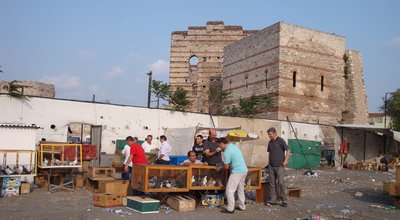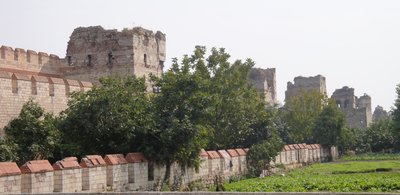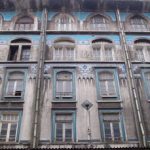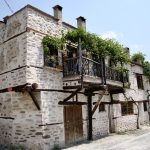It’s my last day in Istanbul so I’ve decided to do something I ought to have done years ago, namely walk along the Land Walls that provided the Byzantine city with protection for so many centuries from Yedikule to Ayvansaray. Somehow there’s always been something standing in the way of doing this. The weather was too hot or too cold, the day was too short, my schedule was too jam-packed. Now though I’m clean out of excuses, so I hop a taxi and head for Mermerkule and the breach in the walls created in the 1950s when Henri Prost presided over a plan that drove the new Sahil Yolu (Kennedy Caddesi) straight through them. How Fatih Mehmet would have envied him. No need for a great Hungarian cannon called Urban to do the job, just mighty bulldozers and a local authority with an eye to the future rather than the past.
Poor old Mermerkule (Marble Tower) is now stranded on its own on the seaward side of the road and I decide against risking my neck to take a closer look and instead turn sharp right and stroll through the Peace Park newly laid out beside the walls. I do this warily since Turkey is very fond of what look like thoroughfares that turn out to have their exits blocked so that you have to loop right back to your starting point again. What’s more, the walls have a reputation for attracting the alcohol-loving fraternity and I don’t fancy bumping into one of them in an enclosed space. All’s well, however, and instead of alkies the park turns out to contain one of those curious pieces of public “sculpture” that always cause my eyebrows to rise. This one, my friend Julie and I decide, probably depicts a pair of pomegranates (or possibly onions). Why pomegranates and why here is not obvious, which may be why the sculptor has wisely failed to append his or her name to their handiwork.
Alongside the park the walls rise upwards, a patchwork quilt of brickwork from the Byzantine to the 21st century in which the Byzantine brick looks soft and sinuous, the 21st century version sharp-edged and crude. Across the road we can see the soaring new skyscrapers of Zeytinburnu whose profiles threaten to mar the silhouette of the historic peninsula. But we’re buoyed up by enthusiasm for our endeavour and skip out of the gates, over a street dog that is hogging the pavement, round a petrol station, under a railway bridge and on to Yedikule (Seven Towers), the more obvious starting point for this walk as it’s where the banliyö train from Cankurtaran (Sultanahmet) deposits passengers. Yedikule is the Tower of London of İstanbul, a fortress that evolved over time into a blood-soaked prison where those who’d offended the sultan (and even one hapless sultan himself) found themselves incarcerated. But we’ve a long walk ahead of us and decide not to fritter away energy on sightseeing. I glance at the shape of the Porta Aurea, the Golden Gate through which the Byzantine emperors used to enter the city after a victory, still clearly visible in the walls despite having been blocked up many centuries ago, and then we press on.
These days the main road runs virtually all the way along the walls which means that you can hardly get lost if all you want to do is follow them. Shortly after Yedikule, though, we divert inside the walls and stroll through a little neighbourhood of neat residential apartment blocks that look out onto the soot-blackened remains, here resembling the raggedy teeth in the mouth of a down and out. A fishmonger strolls past with his wares on a pushcart. We try to take a turn round the pretty garden of the Hacı Piri Cami but find the gates locked against us.
Feeling the walls slipping away from us, we turn sharp left again past one of the many late 19th-century churches that are dotted about the city, almost always virtually hidden behind lofty walls topped with barbed wire and guarded by security cameras; the brick building on the street corner must have been, we conclude, the Rum (Greek) school that would have been linked to it. The road brings us out at the Belgradkapı and shortly afterwards we see the shiny new outline of the Silivrikapı Skating Rink rising up beside the walls, this being a part of town where sports facilities slug it out with sprawling cemeteries for space.
For much of the way the old moat that once stretched in front of the walls has been turned over to allotments which are carefully tended and add an unexpectedly rural twist to the scenery despite the busy main road. Today is Sunday and many of the allotment owners have set up stalls by the road where they’re selling their produce: fresh tomatoes, aubergines, peppers, beans, pumpkins, lettuces, cabbages, corn and juicy purple figs. At the Silivrikapi (Silivri Gate) itself we cut inside the walls again, noting their double thickness, once so useful for defensive purposes, now mainly a hindrance to traffic. Just inside the gate we take a look at the gracious Hadım Paşa Cami, a work of Sinan dating back to 1551, before heading north along the walls again, staying on the inside where it’s quieter. Here it’s possible to get a glimpse of a side of Old İstanbul that tends to get overlooked, a part of the city where shack-like gecekondus still squeeze into the minuscule spaces between shops and garages. If what has happened in Sulukule is anything to go by, however, their days must surely be numbered.
A little further north the road ambles past the intriguing 19th-century Bala Tekkesi complex where a mosque, shrine and schoolhouse form two sides of a triangle with a long, low, elaborate fountain consisting of two sebils and a number of individual taps forming the third. Amazingly this building actually serves as a home to squatters who probably go about their lives with a complete disregard for its historic importance.
From here we find ourselves wandering in a network of narrow streets with, tucked up in the middle of them, the ruins of the Tarsuslu Mescidi which, like so many minor religious buildings, is being rebuilt. Once again we emerge onto the main road and strike north towards Topkapı, the Cannon Gate. Those with long memories will remember that it was here that bus passengers from Europe used to be dropped off in a scene of utter chaos before the coming of the Esenler otogar. Today the area in front of the gate is still a messy transport intersection where the tramway meets the Metrobus amid pounding traffic, but now there’s also a large landscaped park with several attractive porticoed mosques and the flashy new 1453 Panorama Museum where wall-walkers can pause to take a look at a 360-degree reconstruction in sound and images of what the area would have looked like on the fatal day in May 1453 when the Ottomans led by their great general Fatih Mehmed finally forced their way through the seemingly impenetrable walls. The last Byzantine emperor is believed to have died fighting for his fiefdom somewhere nearby.
We are, frankly, in need of a rest by now, so it’s great to discover that Fatih Belediye has installed here one of those wonderful Sosyal Tesisleri places where food and drink is usually pretty good and priced to suit local Turkish pockets and not those of the tourists. As I tuck into my meatballs a bride comes strolling through on her way to be photographed with the walls as a backdrop. How history makes a mockery of everything! Once this was the scene of fierce and epoch-altering struggle. Now it’s just a playground, the history mere wallpaper.
Refreshed, we keep walking along the inside of the walls, passing on the right a pair of 19th-century churches, one Greek, the other Armenian. Ahead of us on the horizon rises the Mihrimah Sultan Cami, the mosque complex with which Sinan crowned the sixth hill of Old Istanbul in 1565. Soon we reach Vatan Caddesi, the second of the major roads to be punched through the walls in the 1950s. Here we duck into the underpass to cross the road and are rewarded for our diversion with a copy of 19th-century court painter Fausto Zonaro’s famous image of Fatih Mehmed approaching the walls alongside Urban in the tilework.
Emerging from the underpass we whip out onto the main-road side of the walls which, here, stand especially proud, the brickwork studded here and there with pieces of old Byzantine masonry clearly reused from elsewhere. As we near Edirnekapı we begin to see, peeping up above the walls, the new and controversial houses that are being built in Sulukule, until recently a neighbourhood of Romany gypsies believed to have been one of the oldest in Europe. The slum houses didn’t stand a chance, though, against developers who were itching to get their hands on such a plum piece of real estate. In truth, the glory days of Sulukule were long behind it anyway, the old music halls, once famous for their belly-dancers. long since closed down leaving the residents to a much diminished way of life. Slum clearance? Ethnic cleansing? Sensible town planning? You will have to make up your own mind.
At Edirnekapı it would be possible to divert to visit the Chora Church but instead we keep on heading north until eventually we see ahead of us the pretty patterned brickwork and windows of the Tekfur Sarayı, the building that may have served as part of the late Byzantine palace before going on to house a pottery and a zoo. Here, to my great delight, we stumble upon the weekend pigeon market, something I had thought long since moved away. By now it’s late in the afternoon so the ground is littered with rubbish and most of the trading is over, but there are still plenty of men (and it’s all men) clustered around the wooden cages discussing the finer points of pigeon flesh and sometimes taking a fancied specimen for a sample flight on the end of a leash. There are other birds on sale here too – chickens, canaries, goldfinches and even one poor redpoll – but it’s the pigeons that rule the roost.
At this point we manage to lose our bearings as the main road and the walls finally part company and soon we’re lost in the back streets. Eventually we emerge again at Eğrikapı, the Crooked Gate, where the path of the walls acquired a chink to avoid disturbing a particularly revered grave. Just to the south stands the restored Kırkçeşme Maksem, the huge stone water storage unit that is the pair of the one in Taksim Square and where water brought into the city from Thrace was stored ready for redistribution. Here we make a mistake and continue north on the outside of the walls until eventually we find the path vanishing, leaving us to scramble down the banks and track a drainage channel until we can find a place to cross into the large park that stands in front of the walls as they near Ayvansaray. This says everything for the failure to capitalise on the potential of the walls. It’s astonishing that there is still no single marked path alongside them, nor yet any signs to indicate which gate is which or even to explain the history of the walls. Only near the Edirnekapı is there one signboard to identify the Porta Xylokerkou (Gate of the Wooden Circus) where the Janissaries first broke through the walls and then it’s in Turkish only. A missed opportunity although one that will probably be rectified in the foreseeable.
Ironically it’s at Ayvansaray, a part of town that few tourists ever visit, that the walls are at their most dramatic, not least because of a string of late Byzantine towers that still stand largely intact and where restoration has been carried out more sensitively than at the Mermerkule end. I especially love this part of the walls because of the cute little cemetery that lurks out of sight inside the walls. Here the gravestones are painted green and white and are, in summer, interspersed with roses. The graves housed in the shrine here are of two companions of the Prophet Mohammed and a man who took part in the fighting in 1453 and they are especially revered which means a steady string of visitors, many of them members of a religious order whose women are shrouded from head to toe in black.
Just past the cemetery the land walls finally meet up with the less preserved Sea Walls that ran alongside the Golden Horn but we have been walking for the best part of five hours now, so this is journey’s end.
Written: 25 September 2011 (Since this blog was written the Mermerkule has been reunited with the rest of the walls.)



